Did Us Go to War Again After Spansiui American War
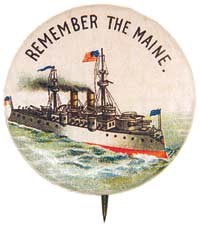
Robert Bowen Collection
On April 21, 1898, the Usa alleged state of war confronting Kingdom of spain. Information technology would be the first overseas conflict fought by the U.S. Information technology involved major campaigns in both Republic of cuba and the Philippine Islands.
The reasons for war were many, simply at that place were ii firsthand ones: America's support the ongoing struggle by Cubans and Filipinos against Castilian rule, and the mysterious explosion of the battleship U.Due south.S. Maine in Havana Harbor.
Half a globe abroad and only 11 days later on the war began, the Castilian Pacific fleet in Manila Bay was defeated by the U.S. Navy in swift strike made by Commodore George Dewey. Unaware of Dewey'due south quick success, President McKinley ordered troops to mount a campaign against the uppercase of Manila.
The military base best suited to stage this entrada was the Presidio of San Francisco. Volunteer soldiers from all over the United States gathered and trained at the Presidio before the long body of water voyage to the Philippines.
Their quest was described as a "splendid lilliputian war" by Secretary of State John Hay.
The Presidio'due south Role
The Presidio was a natural choice because it is next to the finest harbor on the West Coast. The post likewise had enough land to house and train large numbers of troops.
The first overseas units left the Presidio in May 1898. They were the 1st California Infantry and the 2nd Oregon Infantry Regiments. Shortly volunteer units from Washington Land, Montana, Iowa, Wyoming, Kansas, Tennessee and Utah would be stationed at the Presidio. From the beginning of the war to 1900, some 80,000 men passed through the post on their way to and from the Philippines.
At the turn of the century, San Francisco offered many attractions, but army life at the Presidio was cramped, and sickness often flared up in the temporary tent camps. This state of affairs prompted the military to improve troop facilities and helped change the confront of the Presidio over the ensuing years.
Fighting Continues in the Philippines
Philippine rebels had been waging guerrilla warfare confronting Spanish colonialism long before the U.S. became involved. Their exiled leader, Emilio Aquinaldo, communicated with the U.Due south. Army already on its style to the Philippines. He believed the United States would assistance the "Insurrectos" proceeds independence from Kingdom of spain.
Just the U-Southward authorities had some other idea. After the signing the peace treaty with Spain in late 1898, the U.S. gave Cuba its independence but kept the Philippines. The Philippine nationalists were outraged and it sparked a biting and controversial conflict called the Philippine War.
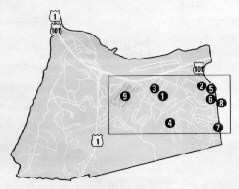
Impact of the Spanish American War on the Presidio
The mark of the cursory war with Spain and the longer conflict with the Philippines is evident throughout the Presidio. The inflow of large numbers of troops spurred its transition from a frontier military outpost to a modernistic army base. Buildings like the Montgomery St. Barracks and the Letterman Hospital circuitous are now an important part of the historic scene.
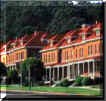
ane - Montgomery Street Barracks: Five brick billet forth Montgomery Street were built between 1895 and 1897 to provide permanent quarters for troops destined for overseas duty. Each barrack could firm 2 companies of 109 men. For a time in 1898, an Army General Field Hospital was established in some of the billet afterward soldiers became sick in the damp conditions at Army camp Merritt, a tent encampment for volunteers near the Arguello Gate.

2 - Ordonez Gun: This type of littoral arms piece was developed by Spanish Captain Salvador Diaz Ordonez in 1880. This particular weapon was supposedly damaged at Subic Bay in the Philippines by shellfire from the U.S.S. Charleston in September of 1899. But some historians believe an explosion of a shell within the gun damaged the butt instead of a direct striking. Publisher William Randolph Hearst brought the gun to San Francisco by the time of the 1906 earthquake and the Army acquired it in 1973 to showroom at the Presidio.
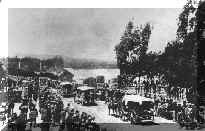
Golden Gate National Recreation Area, Park Athenaeum
3 - Letterman Infirmary Complex: The complex began as a tent hospital at Military camp Merritt in 1898, when the post was overwhelmed with troops sickened past unhealthy living conditions. The hospital was designated a U.S. Army General Field Hospital that same yr and was temporarily housed in the Montgomery St. Billet. The infirmary was permanently located closer to the troop camps nigh the Lombard Gate and to the docks where patients were unloaded from ships. The first phase of the complex was completed in June 1899.
4 - Tennessee Hollow: This was the site of tent camps of the 1st Tennessee and 1st Utah Volunteer Infantry Regiments in May 1898. Once called Army camp Miller, it split into ii separate camps geographically separated by a low ridge: Merriam, or the East Cantonment on the eastern border of the post; and Tennessee Hollow, or the W Cantonment, at this site. Tennessee Hollow, in the valley east of Officers' Row along Funston Ave., was a more open ravine at that fourth dimension, with fewer smaller copse, and no houses.
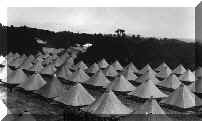
5 - Camp Merriam: Brigadier General Henry Merriam was the commanding general of the Section of California in 1898. The camp was on the eastern border of the Presidio shut to the Lombard Gate (now the site of Letterman Digital Arts Center). It sheltered the first volunteers shipped to the Philippines. The living weather at Camp Merriam were considered to be ameliorate than Campsite Merritt, only south of the Arguello Boulevard Gate.
vi - Plaque in Honor of Col. James F. Smith: This plaque at former Camp Merriam is located
near the Letterman Digital Arts Centre. The plaque marks where the 1st California Regiment of Volunteer Infantry camped while awaiting ship across the Pacific. The plaque, given by the regiment, commemorates their commanding officer for deportment in Guam and the Philippines.
7 - Monument to the 51st Iowa Volunteer Infantry: A rock monument at the corner of Ruger Street and Sherman Road marks the camp site of the 51st Iowa Volunteer Infantry Regiment which in 1898-1899 trained at Camp Merriam before shipping out to the Philippines. On Ruger Street are infantry barracks congenital between 1903 to 1909 to provide better housing for overseas-bound and returning troops.
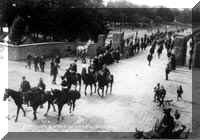
8 - Lombard Gate: Two sandstone pillars, ornamented with army insignia and flanked by captured Spanish cannon mark the Presidio's chief entrance. The gate was built in 1896 to permanently mark the boundaries every bit well equally to improve the postal service's appearance to San Francisco civilians. Most troops en route to the Philippines passed through this gate to run across awaiting ships.
9 - San Francisco National Cemetery: In 1884 the State of war Department designated the quondam post cemetery and surrounding land equally the first National Cemetery on the Due west Coast. It gradually accumulated more than land, because of the inclusion of burials from abased forts effectually the western U.Southward. and the casualties of the Castilian American War and the Philippine American conflict, until reaching its current size of 28 acres. Major Full general Frederick Funston, hero of the Philippine Insurrection, and Major General William R. Shafter, the commander of the forces in Cuba, are buried here.
Source: https://www.nps.gov/prsf/learn/historyculture/spanish-american-war-a-splendid-little-war.htm
0 Response to "Did Us Go to War Again After Spansiui American War"
Post a Comment